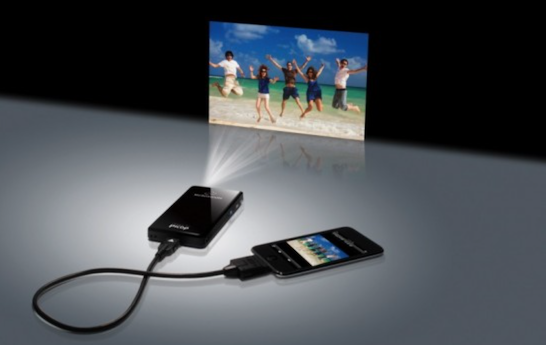Home
A comprehensive resource for safe and responsible laser use

Safety of laser pico projectors
Pico projectors are small video projectors, often battery powered. The light source can use light-emitting diodes (LED) or laser diodes. The remainder of this discussion will be about laser pico projectors.

The MicroVision ShowWX+ laser pico projector is about the size of an iPhone
The laser light emitted from a pico projector is very different than light from a laser pointer. It is much more divergent, since the goal is to display a relatively large image -- not a dot.
Regulatory implications
Any laws and regulations that apply to “lasers” should be careful to define how the term applies to high-divergence laser sources such as pico projectors. For example, a law trying to control laser pointer and handheld laser misuse should exclude laser-based pico projectors. Some sample wording is discussed on the page If you are writing a laser law.
Safety implications
Responsible manufacturers take the safety of laser pico projectors seriously. The unit pictured above is Class 2. This is the same as laser pointers below 5 mW (the U.S. legal limit for selling a laser as a pointer).
Class 2 lasers are considered safe due to a person’s blinking, moving or looking away from a bright light. The laser will not cause harm in the time it takes to avoid the beam. However, intentional staring can be unsafe, so use by minors should be monitored -- just as with laser pointers.
More information is available in papers by Dr. Edward Buckley of the University of Cambridge (PDF downloads):
Eye-safety analysis of current laser-based LCOS projection systems
Eye-safety analysis of current laser-based scanned-beam projection systems
Case study of a possible laser picoprojector eye injury
In August 2017, a person wrote to LaserPointerSafety.com regarding a possible eye injury from a laser pico projector.
The person had purchased a $400 laser pico projector, from a major, world-famous manufacturer. These are the specifications:
Class 3R
Wavelength: 445-639nm
Beam Divergence: 4.5mrad.
Pulse Frequency: 60hz
Output: 206mW
IEC 60825-1:2007
He used the pico projector to trace images onto paper. The brightest exposures were when the projector was less than a meter from the wall, and his eyes were less than 1/2 meter from the paper. He would trace like this up to 6 hours at a session. He did about 7-8 sessions during March 2017.
In June 2017 he began to have problems in his right eye: “Street lights and car headlights started to appear unusually blurred and bloomy at night, sharpness of objects at a distance in the daytime dropped noticeably from my normal prescription (which itself had barely changed at all over the last 20 years prior to this), and it began to feel like there was constantly a foreign object in that eye.”
A visit to an optometrist failed to find a foreign object, and other tests were inconclusive.
This is when he wrote to LaserPointerSafety.com. He wanted to know if looking at the laser pico projector light for so long could have had an effect. (Although he did not have direct laser light in his eye, there are situations where looking at diffuse ultraviolet or blue light can cause photochemical damage to the cornea and lens, similar to sunburn.)
We wrote to some top laser safety experts. They agreed that the laser light exposure did not seem hazardous, and the cause likely lay elsewhere:
Expert 1:
His description of his viewing conditions of diffuse reflections does not sound to me potentially hazardous — particularly if the projected image was comfortable to view. His description sounds like it would be more plausible to suspect and age-related conditions; but, you do not indicate his age. I have encountered many a case of an age-related change being wrongly attributed to light exposure from a copy machine, photo light sources, etc.
Expert 2:
My thoughts were the same,… potentially age-related issues. I was surprised how quickly this became an issue with my own eyes.
Expert 3:
Other causes of these vision changes should be investigated. Medications and health should be considered. Blurry vision and bloody lights at night could be caused by lens or retina problems. The pain sounds more like a corneal problem, foreign body or recurrent corneal erosion or possibly anterior uveitis.
I would like to know his visual acuity, Amsler grid results, OCT, and maybe fluorescein angiography. If he is relatively young to middle aged, central chorioretinopathy (CSC) should be considered. That is a disease in which a serous detachment of the neurosensory retina occurs over an area of leakage from the choriocapillaris through the retinal pigment epithelium (RPE). Other causes for RPE leaks, such as choroidal neovascularization, inflammation, or tumors, should be ruled out to make the diagnosis.
The causes of CSC are not fully understood. It is thought that any systemic exposure to a corticosteroid drug can bring about or worsen CSC. Corticosteroids are found in allergy nose sprays and anti-inflammatory skin creams available over the counter, and are often prescribed to treat a variety of medical conditions.
Age-related macular degeneration is more likely in older patients. While that develops slowly symptoms can occur with over a short time. If associated with fluid the prognosis is worse.
I agree with [Expert 1] that chronic long term diffuse reflection at these wavelengths would not be expected to cause photochemical damage to the retina.
Sudden blurry vision can have many etiologies.
An extensive exam is certainly indicated.
Additional resources
Wikipedia page on pico projectors
Pico projector review website